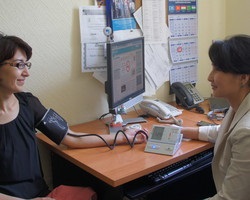ESC Congress 2024, Paris — The European Society of Cardiology (ESC) has released updated hypertension guidelines, marking a significant shift towards more aggressive blood pressure (BP) targets. Unveiled at the ESC Congress, the new guidelines aim to simplify treatment protocols and align more closely with current American standards.
Lower BP Target for Treated Patients
One of the most notable changes in the guidelines is the reduction of the systolic BP target for most patients receiving treatment. The new goal is a systolic BP between 120 mm Hg and 129 mm Hg, a departure from the previous two-step approach that recommended first lowering BP to less than 140/90 mm Hg before aiming for less than 130/80 mm Hg. This adjustment is grounded in recent clinical trials showing that lower BP levels significantly reduce the risk of cardiovascular events.
“This change is driven by new evidence confirming that more intensive BP treatment targets lead to better cardiovascular outcomes across a broad spectrum of patients,” explained Dr. Bill McEvoy, co-chair of the guideline committee and a professor at the University of Galway, Ireland.
Introduction of Elevated BP Category
While the guidelines maintain the definition of hypertension as a systolic BP of 140 mm Hg or higher and a diastolic BP of at least 90 mm Hg, a new category termed “elevated BP” has been introduced. This category is defined by a systolic BP of 120 mm Hg to 139 mm Hg or a diastolic BP of 70 mm Hg to 89 mm Hg. Patients in this category will undergo cardiovascular risk assessment to guide treatment, particularly those with BP levels of 130/80 mm Hg or higher.
“This new category recognizes that hypertension often develops gradually,” McEvoy noted. “By identifying and treating individuals at risk earlier, we can prevent progression to full-blown hypertension and its associated complications.”
Updated Lifestyle Recommendations
The updated guidelines also emphasize lifestyle modifications as a key component of hypertension management. They now include a recommendation for 75 minutes of vigorous-intensity aerobic exercise per week as an alternative to the previous suggestion of 2.5 hours of moderate-intensity exercise. Additionally, potassium supplementation is advised for patients without moderate or advanced chronic kidney disease, either through salt substitutes or a diet rich in fruits and vegetables.
Renal Denervation for Resistant Hypertension
For the first time, the ESC guidelines recommend renal denervation as a treatment option for patients with resistant hypertension that remains uncontrolled despite a three-drug combination. However, this intervention is advised only at medium- to high-volume centers and is not recommended as a first-line treatment due to the lack of evidence showing cardiovascular benefits.
Alignment with US Guidelines
The new European guidelines are now more aligned with American guidelines, which also advocate for a BP target of less than 130/80 mm Hg for most patients. This harmonization is seen as a positive step towards global consensus in hypertension management.
“These new guidelines simplify recommendations with a specific lower BP target, which is a significant move forward,” said Dr. Eugene Yang, chair of the Hypertension Writing Group at the American College of Cardiology. “The alignment between European and US guidelines will help reduce confusion and promote better treatment outcomes worldwide.”
Despite these updates, some experts, including Dr. Yang, express concerns over the requirement for cardiovascular risk assessment in patients with BP in the 130 mm Hg to 139 mm Hg range, citing it as potentially complicating treatment decisions.
Conclusion
The updated ESC guidelines represent a major shift towards more aggressive and simplified hypertension management, reflecting the latest evidence on the benefits of lower BP targets. While the inclusion of new treatment options and lifestyle recommendations offers a comprehensive approach to managing hypertension, the ongoing challenge will be to balance these changes with the need for straightforward, accessible treatment protocols.
These new guidelines underscore the importance of personalized care, where treatment decisions are tailored not only to BP levels but also to individual cardiovascular risk profiles. As the medical community continues to refine hypertension management strategies, these updates promise to enhance patient outcomes across Europe and beyond.












